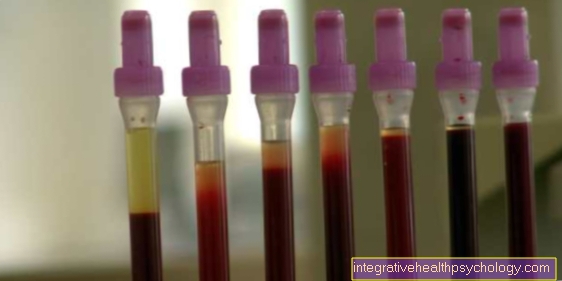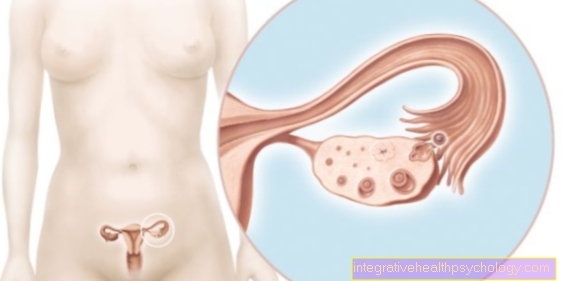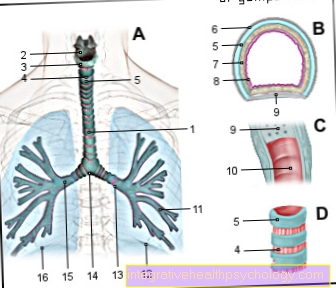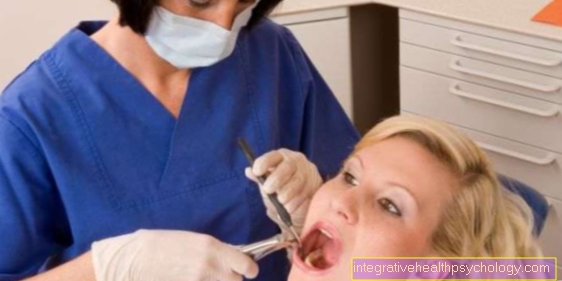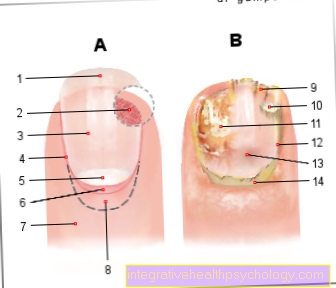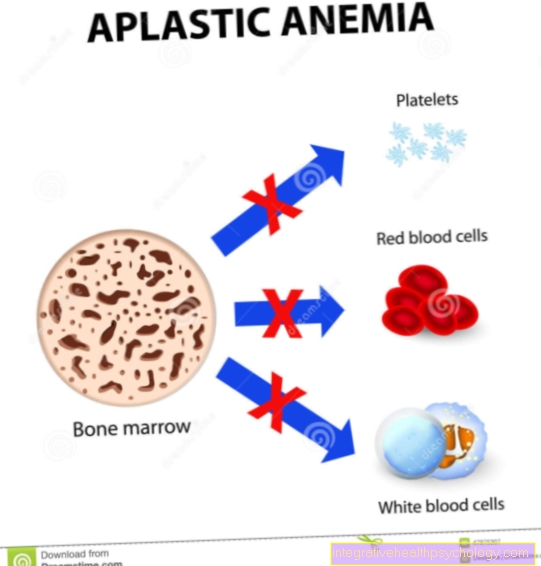break of collarbone
Synonyms
- Clavicle fracture
- Clavicle rupture
- Collarbone fracture

overview
The collarbone (Latin: clavicula) is a bone in the Shoulder girdle and connects the sternum to the shoulder blade. It plays a key role in shoulder movement and maintenance stability. The broken collarbone is one of the most common, but more likely harmless Broken bones. In approx. 80% the fracture of the collarbone occurs in the middle part of the bone, the rest 20% are distributed over the two end parts. In addition to conservative therapy, surgery is indicated in the case of a broken collarbone, if there is a complicated broken collarbone, in order to ensure that it is as complete as possible recovery to reach.
Symptoms
Classic signs of a broken collarbone / clavicle fracture are:
- Swelling and pain over the collarbone
- Hematoma discoloration (Bruise)
- Misalignment
- Function restriction (Functio laesa), especially when lifting your arm
- Crepitation (Bone rubbing)
The affected arm is carried by the patient in a relieving position close to the body, an actual movement in the shoulder joint no longer takes place (Functio laesa).
When looking at the patient, there is a swelling and often also a step formation in the course of the collarbone. The skin is mostly uninjured; Open collarbone fractures with exposed or piercing bone parts are the exception.
The patient complains of considerable pressure pain over the broken collarbone.
Every attempt to move the shoulder joint is perceived as extremely painful, and often it can produce rubbing noises of the broken bone (crepitations).
Together with a significant misalignment of the collarbone and open collarbone fractures, the Crepitatio a sure sign of the presence of a fracture.
During the examination, it must never be forgotten to look for accompanying vascular and nerve injuries in order to avoid consequential damage through possible early intervention and, in case of doubt, to distinguish between the accident-causing and therapeutic (iatrogenic) To be able to differentiate the genesis of possible complications.
You should also always look for further consequences of injuries:
Injuries to the shoulder
- Injuries to the lungs (pleural spike caused by bone fragments)
- Injuries to the chest
- Injuries to the spine
Appointment with ?

I would be happy to advise you!
Who am I?
My name is dr. Nicolas Gumpert. I am a specialist in orthopedics and the founder of .
Various television programs and print media report regularly about my work. On HR television you can see me every 6 weeks live on "Hallo Hessen".
But now enough is indicated ;-)
In order to be able to treat successfully in orthopedics, a thorough examination, diagnosis and a medical history are required.
In our very economic world in particular, there is too little time to thoroughly grasp the complex diseases of orthopedics and thus initiate targeted treatment.
I don't want to join the ranks of "quick knife pullers".
The aim of any treatment is treatment without surgery.
Which therapy achieves the best results in the long term can only be determined after looking at all of the information (Examination, X-ray, ultrasound, MRI, etc.) be assessed.
You will find me:
- Lumedis - orthopedic surgeons
Kaiserstrasse 14
60311 Frankfurt am Main
You can make an appointment here.
Unfortunately, it is currently only possible to make an appointment with private health insurers. I hope for your understanding!
For more information about myself, see Lumedis - Orthopedists.
How bad is the pain?
A broken collarbone can be very painful. With this type of fracture, pain is very subjective and can be minor but also very extreme. Important factors that can aggravate pain are the position of the break lines and the damage to the tissue around the collarbone. If the break lines are well aligned, the risk of injuring surrounding nerves, blood vessels or other types of tissue is reduced. In extreme cases, a sharp protruding break edge can pierce through the skin or the pleura, which can lead to a collapse of the lungs.
A fracture always injures the surrounding tissue. As a rule, this affects the periosteum, smaller blood vessels and small nerve endings. In the case of a broken collarbone, however, major arteries and nerves that pull from the neck region into the arm can also be involved. These minor injuries can also explain a bruise that occurs in most cases with a fracture. This causes swelling and extreme pain when subjected to external pressure. As a result, the collarbone fracture causes pain with any movement in the shoulder, including breathing or movements in the cervical and thoracic spine.
How long does the pain last?
The duration of the pain depends on the initial severity of the pain, the extent of the break, and the progression of healing. Children must be immobilized for about 3 weeks. The pain duration is on average 2-3 weeks, with the pain decreasing daily. If the pain medication is slowly reduced, the severity of the pain can subjectively increase, but this can be related to the dose reduction.
The duration of pain may be longer if there is major tissue damage as a result of the break. The healing phase may be a few weeks ahead, especially when larger ducts or the pleura are involved.
What can you do about the pain?
The main pain can be attributed to the local swelling at the break point with extreme sensitivity to touch. Immediate measures to reduce the local reaction are immobilization and cooling. In order to be as pain-free as possible in the subsequent healing phase, rest and rest are the top priorities for this fracture. Any movement can provoke extreme pain.
Additionally, until healing progresses, pain medication may provide relief. Pain medication from the NSAID group can be used for this. Their most prominent representatives are Ibuprofen, indomethacin and diclofenac. Your dose must be chosen in such a way that, when the shoulder is immobilized, it is almost free from pain. If this is not possible with these drugs, opiates such as Morphine be prescribed. However, these should only be taken as briefly as necessary, as morphine also causes certain side effects.
You can read about which these can be in our article Side effects of morphine.
Diagnosis and preliminary examinations
Once the broken collarbone is diagnosed, the doctors weigh it up Advantages and disadvantages one OP and one conservative therapy from. In order to be able to make a decision, various preliminary examinations are made. First and foremost, x-rays of the collarbone provide information, possibly supplemented by CT or MRI. This also makes planning the operation easier.
Likewise, motor or sensory deficits and possible circulatory problems are recorded before the operation in order to be able to assess vascular or nerve damage. Additionally be Blood samples examined to in case of complication during surgery Provide blood reserves and to record the coagulation status of the patient, which is important for performing an operation. An EKG is also standard.
Once the extent of the collarbone fracture has been determined and the preliminary examinations have been carried out, the operation can begin once the indication has been clearly established.
Causes of a broken collarbone
With a fracture rate of 10-15% in adults, the collarbone is after the radius near the wrist (distal radius fracture) second most frequently affected by bony injuries.
The cause can be an indirect force of violence (more often), such as a fall on the outstretched, catching arm (e.g. fall from a bicycle) with transmission of the acting force to the collarbone or direct trauma (less often) through a blow or fall to the front shoulder . Traffic accidents (approx. 50%, especially motorcyclists who break their collarbones through the lower edge of the motorcycle helmet) and sports injuries (approx. 35%, most frequent breakage of the cyclist) are the most common causes of broken collarbones.
In approx. 80% of the cases the collarbone / clavicle breaks in the central shaft area, because this is where the diameter of the collarbone is smallest. In approx. 15% of the cases the lateral (side, near shoulder), in approx. 5% the medial (near the sternum) the end of the collarbone is affected. The bone has a larger diameter in these areas, so it is more stable and is additionally stabilized by numerous ligaments.
therapy
A broken collarbone can be treated conservatively or as part of an operation. If you want to operate, the indication must be made clear. The most important criterion for surgery on a broken collarbone is an open fracture, in which the bone spears through the skin. Also heavily displaced, i.e. Fracture ends displaced from one another must be operated on. Additional indications for an operation in the case of a broken collarbone are accompanying injuries to nerves or vessels.
Read more on the subject below Therapy of a broken collarbone.
Surgical treatment of a broken collarbone
The operation of a collarbone fracture is performed under general anesthesia, which is initiated by an anesthetist. A sedative pill is often given before the operation to save the patient unnecessary stress. After the anesthesia has been initiated with intravenous drugs or anesthetic gas, the surgeon begins to expose the fracture. Particular care is taken not to damage any nerves or vessels. During the operation, the bones involved are put together again in an anatomically correct manner and then fixed. Depending on the surgeon and the case at hand, a broken collarbone is treated with metal plates or wires. The plates are fixed to the bone with screws above the fracture gap and thus ensure absolute stability. The bones can grow back together.
Wires are available as an alternative. After the operation, a so-called Gilchrist bandage or rucksack bandage is put on to rest the arm for a few days and then a sling for a few weeks. Once the broken collarbone has healed, the plates are removed after 6-12 months. A new procedure is the fitting of a titanium nail, which is inserted into the medullary canal of the bone in a minimally invasive way and splinted it from the inside. Which procedure is chosen mainly depends on the extent of the break and the surgeon.
Depending on various factors, the duration of the operation itself can be specified as 1-2 hours, in complicated cases the duration can also be longer.
You can also read our article about this Elastic stable intramedullary nailing!
Backpack bandage
The backpack bandage is a very popular conservative therapy method for the broken collarbone. It is pulled around the shoulders like a very tightly drawn rucksack. He pulls the shoulders back, straightens the upper body and restricts the movement in the upper body, which stabilizes the shoulders and the broken collarbone. The break is also pulled apart a little, which prevents the break from growing too short. The immobilization also includes pain therapy at the same time, as it prevents movement in the shoulder.
Outpatient care
In some cases, a broken collarbone is also treated on an outpatient basis, i.e. without an inpatient stay in the hospital. In most cases, an operation requires at least two days of inpatient treatment. But especially with young and sporty patients, it is possible to think about performing the operation on an outpatient basis. Until the anesthesia subsides, the patient is monitored for a few hours and then discharged home.
Nevertheless, the patient must pay attention to some measures after the operation. After an outpatient operation, there is usually a 24-hour driving ban and a ban on operating machines, even with a broken collarbone. A person of trust has to pick the person up from the hospital; important decisions or obligations should also be avoided for the following day.
Whether a broken collarbone is treated on an outpatient basis depends primarily on the extent of the fracture and the patient's fitness. For example, an open fracture or fractures in the elderly should not be operated on on an outpatient basis. Ultimately, the decision rests with the treating medical staff.
Read more on the topic: Therapy of a broken collarbone
Complications
Complications in the therapy of a broken collarbone can occur with conservative as well as surgical therapy.
Complications with conservative therapy:
- Slipping of the fracture / fracture (secondary dislocation)
- False joint formation (pseudarthrosis)
- Excessive callus formation with vascular nerve compression
- Cosmetically disruptive callus formation (distended key community)
Complications of surgical therapy:
- Vascular and nerve injuries (very rare): The vessels and nerves supplying the arm run relatively close below the collarbone. If the fracture-stabilizing plate is to lie on the collarbone, vertical drill holes must be made for the plate screws. This can lead to vascular and nerve damage. It is therefore recommended to attach the plate to the collarbone from the front. With the same stability, the risk of vascular and nerve damage is lower.
- infection: The soft tissue covering over the collarbone is very thin. The risk of post-operative infection is not insignificant.
- Metal loosening: Metal loosening or even metal fractures occur. Strong static and dynamic forces act on the collarbone.
- False joint formation (pseudarthrosis): If the collarbone has not healed after 6 months, it is referred to as delayed bone fracture healing, as well as permanent false joint formation. Due to the lack of bone healing, pathological residual mobility remains in the fracture area, hence the wrong joint. Corrective surgery (revision surgery) is required in the case of a discomforting false joint. To stabilize the fracture, either spongy bone (cancellous bone) is attached to smaller false joint zones or a bone chip from the body's own iliac crest is interposed and flattened in larger areas.
- Cosmetically disruptive scarring: Especially with young people and skin incisions made parallel to the collarbone, excessive, cosmetically disruptive scarring can occur due to the chest muscle pull. This is why the saber cut is recommended for young people, as it is not exposed to such tensile forces due to its vertical course. The disadvantage can be a poor overview during the operation.
Read more on the topic: Pain in the collarbone
What can be long-term effects?
As a rule, the broken collarbone heals well and complications are rare. Poorly standing fractures can now also be treated well with a reduction in size or surgery. If this is not done, however, the bone can grow together at an angle and form a false joint. An elevation at the break edge can be felt permanently from the outside. Externally visible deformities and posture errors can result. In children in particular, an improperly healed fracture can lead to stunted growth and asymmetry of the shoulders.
Duration and forecast
In the vast majority of cases, the operation is unproblematic, so that the broken collarbone is well cared for and heals without restrictions after a while. Movement and resilience are then fully developed again. Initially, of course, the bone is only partially resilient, with targeted training and the necessary caution, healing usually goes extremely well. A correction is only necessary in exceptional cases or a restriction remains.
After the fracture of the collarbone has been treated with surgery, it takes a few weeks to heal. First you wear a cast or a sling. On the first day after the operation, slight movements in the sling are possible. The duration of the hospital stay is usually 2 days, after which the sling can be removed in about week 3. The broken collarbone is not completely healed for about 12 weeks, so you should only start with partial loads from the 6th week. After 6-12 months, the remaining metal plates are removed.
The healing of a broken collarbone is a process that takes a few weeks and is influenced by various factors. Healing sets in immediately after the operation, as the joined bone parts start to grow together. In addition to physiotherapy, only light exercise is indicated for the remaining weeks in order not to delay healing. If complications arise, the healing time can be significantly longer, especially if another operation is required. As a rule, however, the healing process goes well even with a complicated broken collarbone. On average, the bone is fully resilient again within 8-12 weeks after a broken collarbone.
In children, on the other hand, the healing time is often reduced. You are advised to wear the backpack bandage for about 10 days. Adults, on the other hand, should leave the backpack bandage for 2-3 weeks with conservative therapy. The break lines should then have grown together. A full load can take place after about 6-8 weeks. After that, the break can usually be described as completely healed. Nevertheless, a certain amount of caution should be observed in the beginning.
The recovery time from complications can sometimes be significantly increased, but these are rare.
How can I speed up the healing myself?
In the acute situation of the injury, immediate immobilization with cooling can minimize the local reaction and reduce the bruise. In the subsequent healing phase, the most important prerequisite for rapid healing of the break is that the break edges lie exactly on top of one another and are not displaced. To do this, a doctor should be consulted as early as possible to check the position of the bones. Then the patient's task is not to move the shoulder and to stabilize the breakpoints. Only in this way can the bones heal as quickly as possible.
How long are you on sick leave after a broken collarbone?
If you have to undergo an operation for a broken collarbone, a sick leave is mandatory. How long the sick leave has to be depends on the individual healing process and the activities that one does during the work. People who physically work primarily with the poor should be given sick leave until they have recovered sufficiently, i.e. at least 4-6 weeks. Afterwards, you shouldn't put yourself under full load and slowly get back to work. If this is not possible, the sick leave can be extended. For people who are not exposed to severe stress and who, for example, mainly pursue office activities, a sick leave of 2 weeks may be sufficient. In all cases, however, this period should not be less than this, as the most important part of the healing process takes place immediately after the operation. Likewise, one should not feel pressured and take sick leave until one feels able to cope with the tasks at work or school again.
What to do if the broken collarbone does not heal?
In rare cases, complications can arise in the course of treatment in which the fracture is not at all or only insufficiently via a so-called "Pseudarthrosis“Heals. In these cases, the attending physician must carefully consider whether healing can be achieved by reducing and “repositioning” the bone, or whether an operation is necessary. After a few weeks of unsuccessful healing, the bone often has to be fixed surgically. For this purpose, the broken ends are placed directly on top of one another and fixed to one another with a plate or with wires. Then the shoulder must be immobilized in the rucksack bandage. Optimal healing must be sought, especially with young people, so that misalignments and visible deformities do not occur in the long term.
Can you drive a car with a broken collarbone?
When driving a car, it must be ensured that the vehicle can be operated with both hands and that there is a certain degree of mobility. When wearing a rucksack bandage, mobility is not given, which is why driving a car is prohibited. In the subsequent healing phase, driving is not prohibited per se. In the individual situation, it must be decided in consultation with the doctor whether it is safe to drive a car. This mainly depends on the mobility and the pain associated with it.
Special features of a broken collarbone in a child
Collarbone fractures are a particularly common type of fracture in childhood. The bones are still very fragile in early childhood and the collarbone is the weakest point in the connection between the shoulder and the chest. Falls, which are very common in childhood, can cause the collarbone to give way and break in one or more places. In children, there are three peculiarities that make the fracture of the collarbone more complicated.
First and foremost is the pain, which can be very severe with this type of fracture. Especially in toddler age, children cannot express their pain complaints exactly, but this does not make the pain less severe than in adults. It is extremely important to give a child good and adequate pain management. Children cannot guarantee complete immobilization of the shoulder either, which is why the pain is often exacerbated by movement.
This results in the second peculiarity of the broken collarbone in children. Therapy is much more difficult to carry out than with an adult. As a rule, a straight hernia can be treated well by resting and waiting. In order for the bone to heal well and quickly, the bone must not be moved or displaced. Such therapy can hardly be carried out in children. Further falls can also hold back healing. It is not uncommon for an operation to break the collarbone to be necessary in childhood. If the healing cannot take place in the best possible way, there is a third peculiarity of the broken collarbone in children.
Incomplete healing can have serious consequences, especially when the bones are still growing. The bone grows together crooked and forms what is known as a false joint at the break point. This can also result in restricted growth in the bone. In young children this can lead to asymmetrical growth of the shoulders and chest with long-term poor posture.
Read our article about this Collarbone fracture in children!
Prophylaxis and costs
The costs of an operation for a broken collarbone are made up of various factors.In addition to the costs of materials used, such as screws, plates, sutures, surgical clothing, salaries of the surgeons, etc., the costs for anesthesia, anesthetists and nurses on the ward must also be included. Overall, the costs are in the 4-digit range.
In addition, a bandage or a sling and the necessary physiotherapy are provided after the operation. Since in most cases it is an accident, the costs for surgery and hospitalization are covered by the accident insurance. You can get your first Gilchrist or backpack bandage for at home in the clinic. If you want to have a second one to change, you have to pay for it yourself. In the pharmacy the costs are around 70 €. If you break your collarbone abroad, there can be considerable additional costs if you don't have international health insurance.
In order to avoid an operation on a broken collarbone, one should always pay attention to adequate protective clothing when exercising. The most important thing, however, is to assess your own abilities correctly and not take any daring actions. Of course, the likelihood of a complicated fracture can only be reduced and not avoided, since a broken collarbone is an accident.



-cola.jpg)

